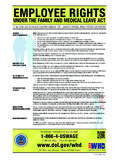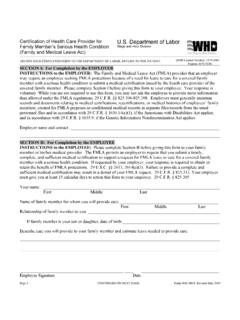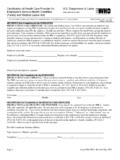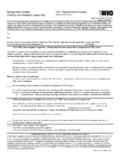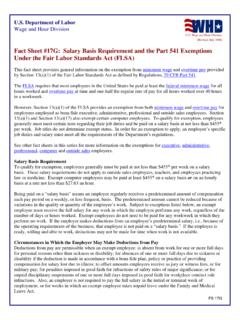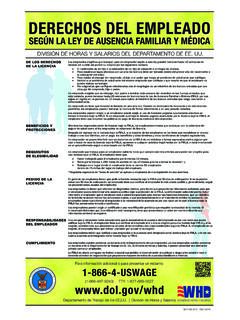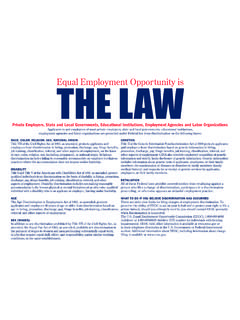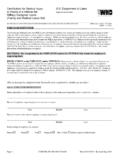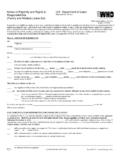Transcription of Glossary of Health Coverage and Medical Terms - DOL
1 Glossary of Health Coverage and Medical Terms Page 1 of 6 (DT - OMB control number: 1545-0047/Expiration Date: 12/31/2019)(DOL - OMB control number: 1210-0147/Expiration date: 5/31/2022) (HHS - OMB control number: 0938-1146/Expiration date: 10/31/2022) Glossary of Health Coverage and Medical Terms This Glossary defines many commonly used Terms , but isn t a full list. These Glossary Terms and definitions are intended to be educational and may be different from the Terms and definitions in your plan or Health insurance policy. Some of these Terms also might not have exactly the same meaning when used in your policy or plan, and in any case, the policy or plan governs.
2 (See your Summary of Benefits and Coverage for information on how to get a copy of your policy or plan document.) Underlined text indicates a term defined in this Glossary . See page 6 for an example showing how deductibles, coinsurance and out-of-pocket limits work together in a real life situation. Allowed Amount This is the maximum payment the plan will pay for a covered Health care service. May also be called eligible expense, payment allowance, or negotiated rate. Appeal A request that your Health insurer or plan review a decision that denies a benefit or payment (either in whole or in part).
3 Balance Billing When a provider bills you for the balance remaining on the bill that your plan doesn t cover. This amount is the difference between the actual billed amount and the allowed amount. For example, if the provider s charge is $200 and the allowed amount is $110, the provider may bill you for the remaining $90. This happens most often when you see an out-of-network provider ( non-preferred provider). A network provider ( preferred provider) may not balance bill you for covered services. Claim A request for a benefit (including reimbursement of a Health care expense) made by you or your Health care provider to your Health insurer or plan for items or services you think are covered.
4 Coinsurance Your share of the costs of a covered Health care service, calculated as a percentage (for example, 20%) of the allowed amount for the service. You generally pay coinsurance plus any deductibles you owe. ( For example, if the Health insurance or plan s allowed amount for an office visit is $100 and you ve met your deductible, your coinsurance payment of 20% would be $20. The Health insurance or plan pays the rest of the allowed amount.) Complications of Pregnancy Conditions due to pregnancy, labor, and delivery that require Medical care to prevent serious harm to the Health of the mother or the fetus.
5 Morning sickness and a non-emergency caesarean section generally aren t complications of pregnancy. Copayment A fixed amount (for example, $15) you pay for a covered Health care service, usually when you receive the service (sometimes called copay ). The amount can vary by the type of covered Health care service. Cost Sharing Your share of costs for services that a plan covers that you must pay out of your own pocket (sometimes called out-of-pocket costs ). Some examples of cost sharing are copayments, deductibles, and coinsurance. Family cost sharing is the share of cost for deductibles and out-of-pocket costs you and your spouse and/or child(ren) must pay out of your own pocket.
6 Other costs, including your premiums, penalties you may have to pay, or the cost of care a plan doesn t cover usually aren t considered cost sharing. Cost-sharing Reductions Discounts that reduce the amount you pay for certain services covered by an individual plan you buy through the Marketplace. You may get a discount if your income is below a certain level, and you choose a Silver level Health plan or if you're a member of a federally-recognized tribe, which includes being a shareholder in an Alaska Native Claims Settlement Act corporation.
7 (See page 6 for a detailed example.) Jane pays 20% Her plan pays 80% Glossary of Health Coverage and Medical TermsPage 2 of 6 Deductible An amount you could owe during a Coverage period (usually one year) for covered Health care services before your plan begins to pay. An overall deductible applies to all or almost all covered items and services. A plan with an overall deductible may also have separate deductibles that apply to specific services or groups of services. A plan may also have only separate deductibles. (For example, if your deductible is $1000, your plan won t pay anything until you ve met your $1000 deductible for covered Health care services subject to the deductible.)
8 (See page 6 for a detailed example.) Jane pays100% Her plan pays 0% Diagnostic Test Tests to figure out what your Health problem is. For example, an x-ray can be a diagnostic test to see if you have a broken bone. Durable Medical Equipment (DME) Equipment and supplies ordered by a Health care provider for everyday or extended use. DME may include: oxygen equipment, wheelchairs, and crutches. Emergency Medical Condition An illness, injury, symptom (including severe pain), or condition severe enough to risk serious danger to your Health if you didn t get Medical attention right away.
9 If you didn t get immediate Medical attention you could reasonably expect one of the following: 1) Your Health would be put in serious danger; or 2) You would have serious problems with your bodily functions; or 3) You would have serious damage to any part or organ of your body. Emergency Medical Transportation Ambulance services for an emergency Medical condition. Types of emergency Medical transportation may include transportation by air, land, or sea. Your plan may not cover all types of emergency Medical transportation, or may pay less for certain types.
10 Emergency Room Care / Emergency Services Services to check for an emergency Medical condition and treat you to keep an emergency Medical condition from getting worse. These services may be provided in a licensed hospital s emergency room or other place that provides care for emergency Medical conditions. Excluded Services Health care services that your plan doesn t pay for or cover. Formulary A list of drugs your plan covers. A formulary may include how much your share of the cost is for each drug. Your plan may put drugs in different cost-sharing levels or tiers.
